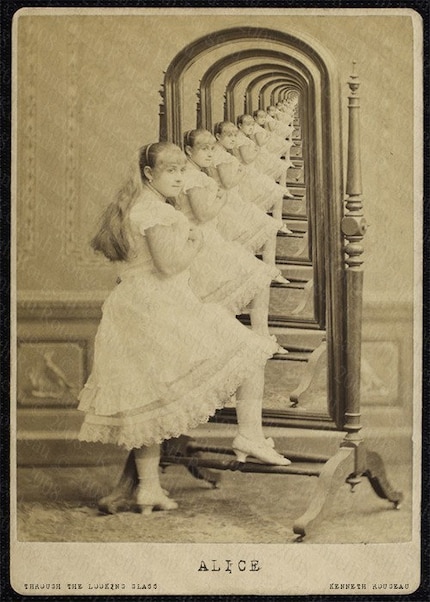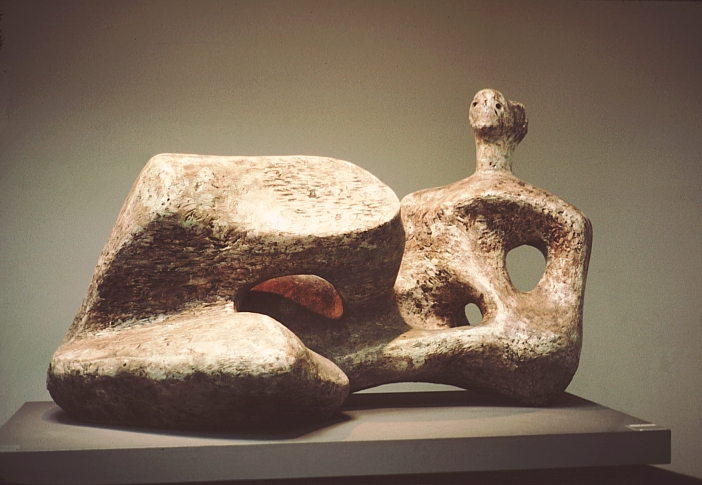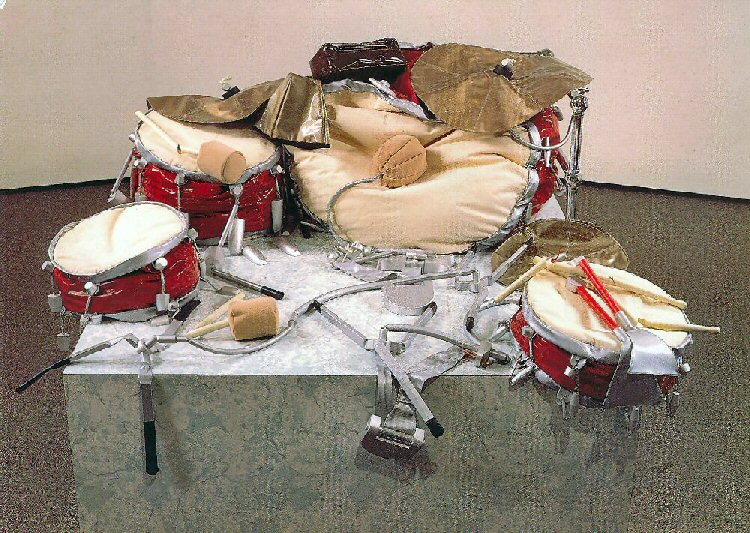a scene from 'Orpee' by Jean Cocteau
The idea of travelling from one world to another is found in religions, myths and literature. In 'Orphee' (1950) Jean Cocteau's retells the Greek myth 'Orpheus and Eurydic' (see more here).
In Cocteau's version Orpheus is a poet who has to travel to the underworld. Cocteau uses the visual device of a mirror as a gateway to the underworld. Throughout the film there are visual reference to mirrors and reflections.
Still's from Jean Cocteau’s 'Orphee'
In this famous scene, Ophee (Jean Marais) enters a new world by penetrating the surface of a mirror. By editing several scenes together (see Photomontage) Cocteau creates the illusion that Orphee passes through the mirror. At the key moment the camera cuts to the actors hands going into a vat of mercury - as if the mirror has turned to liquid.
still from Jean Cocteau's 'Blood of a Poet' 1930
Cocteau had played with the idea of the mirror as a door to another world in his earlier film 'Blood of a Poet' from 1930. A statue tells a young artist that to get out of his studio he has to go through a mirror. In this earlier film Cocteau uses trick photography to make the mirror turn into liquid for the artist to pass through (see the scene here).
'Alice Through the Looking Glass' by Kenneth Rougeau
This seemingly old image is actually modern. Rougeau has created a Droste effect - a particular type of repetitive image. It depicts 'Alice' from Lewis Carol's 'Through the Looking-Glass, and What Alice Found There' (1871). Alice goes through the mirror into a fantasy world populated by peculiar anthropomorphic creatures. Also see 'Alice in Wonderland' 1903 and Jan Svankmajer's - 'Alice' 1988.
Bill Brandt - 'Self Portrait with Mirror' East Sussex Coast 1966
In these above images Brandt has used a maximum depth of field and mirrors to create Surreal images. Rene Magritte was a surrealist painter and his images share qualities with Brandt. The Surrealists were interested in the world of the unconscious and dreams. In dreams the everyday mixes and creates strange juxtapositions.
Most of us have seen rain and we have seen men in suites (Magritte used these figures as short hand for the bourgeois) – they are fairly everyday. In dreams our it could rain business men - as in this above painting by Magritte. These are the kind of Juxtapositions the Surrealists like to play with.
Above is a portrait of Magritte by Brandt that incorporates elements of both artists work. Brandt used mirrors to reflect subjects and create unusual images. Like lenses mirrors bend and distort light and create the image of a world within a world. There is also the effect of a frame within a frame. You see two points of view within one image making the effect similar to the fractured surface of analytical Cubism.
This is Picasso's portrait of the art dealer Ambroise Vollard who championed and was painted by Cezanne (in 1899). Picasso would claim that this is a more truthful portrait than a traditional approach. The image is fractured and made up of geometric planes - like a piece of broken glass. Vollards bald head explodes and is elongated, his downcast eyes seem closed and his features are merely suggested. The whole image has a similar hue - flesh tones, browns, greens and blues. Picasso would move on from cubism (though a stylised version of it can be seen in his later works) - but ultimately Cubism is his key contribution to art.
David Hockney 'Mother I, Yorkshire Moors, August 1985 No.1' 1985
The link between Cezanne's, Picasso's and Braque's fractured multiple viewpoints and Hockney's use of joiners can be seen clearly in this joiner of his mother. Like the portrait of Vollard we can see his mothers face from the front, the left hand side and the right hand side. This is not an abstract approach - this is how we might see Hockney's mothers face if she was in front of us.
Soundtrack Album artwork for the film 'Dancer in the Dark' (2000) dir. Lars von Trier
'Source Code' movie poster
The fractured nature of cubism changed art but it is also seen today in common commercial images. In the bottom poster for the film 'Source Code' the figure is broken up into small fractured shards as if he is disintegrating. The films plot involves a fractured storyline where the main character lives through same 8 minutes of time. The main characters confusion and the broken timeline is reflected in this kinetic image.
Marianne Faithful's version of a portrait by Rankin (from 'Destroy Rankin')
In a collaborative project called 'Destroy Rankin' musicians have 'Destroyed or reinterpreted portraits of themselves taken by Rankin. Rankin takes the original photograph but the final image is, ultimately, a self portrait. This image by Marianna Faithful has the same fractured feel as Picasso and Hockney.
Caravaggio 'Narcisse' 1594-1596
This painting by Caravaggio , famous for his use of light, depicts the Greek myth ‘Narcissus’. This is the story of a young man who falls in love with his own reflection and cannot pull himself away. The moral is to warn people about vanity, being too self centred or caring for shallow things. Due to the reflection this image has a natural balance an use of symmetry. Dorian Grey |
Still from Alfred Hitchcock's - 'Champagne' 1928 - shot through the bottom of a wine glass.
This is a strange still from an early silent Alfred Hitchcock film. It is taken from his 1928 film 'Champagne' were he experimented with a camera lens placed inside a giant champagne glass. The glass fills with liquid and is tipped as if we, the viewer, are drinking from it and seeing through it. We can just make out a crowd and couple dancing.
Still from Hitchcock's 'The Ring' 1927 - a moving reflection in a stream
During the filming of Hitchcock's early silent film The Ring (1927) he experimented with trick photography. In the above still we see a reflection of a couple in a stream. When the water ripples the image itself ripples and the figure go in and out of abstraction.
Stills from Hitchcock's 'The Ring' 1927 - seen from the viewpoint of a drunk man
In these two scenes we see what a drunk sees and the world appears distorted. This could emulate the effect of drink but also be a metaphore for viewingt he world through the bottom of a glass. Dancers distort until they are unrecognizable. Hitchcock uses blurring and mirrors to distort the image and create a sense of disorientation. The keys of a piano appear elongated as if seen through a fairground mirror. This visual experimentation is a key aspect of Hitchcock's Cinematic style.
Andre Kertesz ‘Distortion 144, Paris’ 1933
Andre Kertesz ‘Distortion 147, Paris' 1933
These strange distorted images are by André Kertesz. ‘Distortions’ (1933) is a series of photographs of women reflected in distorting carnival mirrors that transform them into dreamlike creatures.
Salvador Dali 'Soft Construction With Boiled Beans (Premonition of Civil War)',1936, oil on canvas.
The deformed melting figures of Dali's painting mirrors the distortions that appear in Kertesz's photographs. This painting is one of only a handful in which Dalí turned his attention to the tragedy that beset his homeland on July 17, 1936, when General Francisco Franco led a military coup d'état against the democratically elected Popular Front government. The artist's savage vision of his country as a decomposing figure tearing itself apart preceded the outbreak of the Spanish Civil War and thus prophetically foretold the atrocities committed during this bloody conflict. Other artists who have focused on the Spanish Civil War are Picasso (Guernica), Guillermo del Toro (Pan's Labyrinth) and, during the earlier civil war, Goya (Disasters of War). Dada Photomontage distorted the human form immediately after the first world war. As well as having surreal qualities these images, like the Dada Photomontages could be a reaction to the human horrors of the first world war and the rise of 1930's fascism.
Henry Moore. Working Model for Reclining Figure, 1957. Bronze.
Henry Moore emerged in the 1920s as a radical, experimental and avant-garde figure and was rapidly established as the leading British sculptor of his generation. His principal and enduring subject was the human body, through which he believed ‘one can express more completely one’s feelings about the world than in any other way’. Moore also reflected in his work his reaction to two world wars. The smooth quality of these images are similar to the effect of melting ice and how is distorts as it transforms back into liquid.Claes Oldenburg 'Giant Soft Drum Set 1'
Sculptures are traditionally cut from rock or wood. They can be moulded from clay. Oldenburg's everyday objects seem to melt into the gallery floor - evaporating into nothing.



























